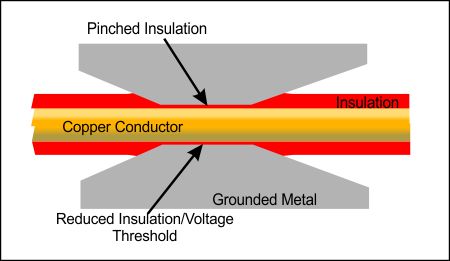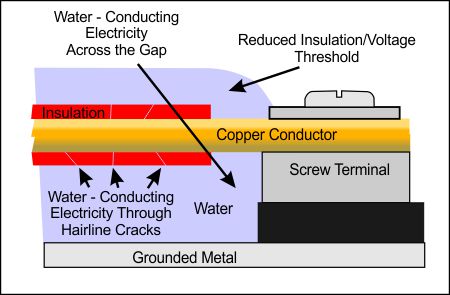How Does One Find a Soft Ground Fault?
A soft ground fault, unlike a hard contact with ground, is an unwanted electrical conduction going through water or bad insulation. There is a electrical leak, but not a hard contact. Often, to find it, an insulation tester is needed.
By Douglas Krantz
Resistance is not futile;
resistance is fickle.
Normally, we think of resistance like that of a resistor. The amount of resistance is built-in; no matter what voltage is used to drive the electrical current through the resistor, the
resistance will not change. Its voltage to current ratio never changes because its resistance never changes.
Resistance Breakdown
However, if enough voltage is applied, the resistor breaks down and its current shoots much higher without much change in voltage. Its voltage to current ratio lowers because the resistance lowers. That's kind of fickle, isn't it?
As an example, at 10 volts, the resistance is the value shown on the stripes. However, say 10 million volts is applied. The resistance changes. The
arc of electricity across the resistor burns it up and for all intents and purposes, the resistor changes to become a conductor.
Yes, I know. The resistor has now gone and even the leads of the resistor have vaporized. However, where the resistor used to be, the ionized air is almost a perfect conductor: the resistance has changed. The voltage to current ratio is now lower because the resistance is now lower.
Let's get back to reality.
Insulation/Voltage Threshold
The resistance of the insulation around a wire is a very high value. If the voltage is high enough, though, the insulation conducts electricity and then burns up: the burned insulation effectively becomes a short.
At a lower voltage than what it takes to burn up the insulation, however, the voltage can be enough to push through a small amount of current. This is where the insulation/voltage threshold comes into play.
Thin/Pinched Insulation
Pinching or rubbing the insulation makes certain spots thinner. Even though the insulation is blocking most electrical current, you could say the insulation is breaking down at that location.
The insulation/voltage threshold is lower at that location on the wire, and the electrical current flowing through the insulation at that point can be the cause of the fire alarm panel detecting a ground fault.
Worn Insulation
Rubbing the insulation on a sharp edge can also be the cause of a lowered insulation/voltage threshold. Even though the insulation is still covering the copper, it is thinner at that point and the voltage required to push electrons through the insulation is lowered.
Insulation Ageing Process
Over time, all insulation ages and reduces its insulating value. Some types of insulation age quicker than other types.
Because the insulation reduces its insulating ability as it ages, the insulation/voltage threshold lowers and then lower voltages will drive electrical current through the insulation.
Water, oil, grease, or other chemicals on the insulation will greatly increase the speed of the aging.
Water Bridging the Gap
Water at lower voltages is an insulator; water at higher voltages is a conductor.
The voltage/insulation threshold of water is greater for distilled water (very high voltage) than it is for dirty water (salt, chemicals, just plain dirt in the water).
Water in building wiring (it's not supposed to be there, but it gets there anyway) usually has an insulation/voltage threshold of about 7 to 9 volts.
Looking for the Ground Fault
Using its internal power supply voltage of 12 to 24 volts, the
fire alarm panel is detecting a ground fault. Using its internal battery of 3 volts, the standard ohmmeter is used to detect the same ground fault.
If the insulation/voltage threshold is below 12 volts but above 3 volts, the fire alarm panel shows the ground fault while the ohmmeter doesn't see it. This is a problem.
Solving the Soft Ground Fault Detection Problem
There are three ways of solving the soft
ground fault detection problem:
- Use a More Expensive Ohmmeter with a higher voltage internal battery, and interpret its unstable ohm readings
- Build Your Own Insulation Tester
- Buy an Insulation Tester
Each of these has good points, and each of these has bad points.
Use an Ohmmeter and Interpret the Unstable Readings
When a soft ground fault is present and if the ohmmeter is good enough, the display will show some conduction to ground. A truly open reading will show infinite ohms, whereas the current leaking to ground through a soft ground fault will be shown somewhere in the high K-ohm to Meg-ohm range. The soft ground fault will be detectable, but the readings on the meter will be unstable.
This is the inexpensive way, does not require the technician to carry a special meter, but requires a real familiarity with the ohmmeter.
One drawback is these readings are hard to interpret and sometimes they show false-positives: the technician can start looking for the soft ground fault in the wrong zone.
Build Your Own Tester
To build an insulation tester for use on fire alarm systems, use the instructions printed in the Nuts and Volts Magazine September 2010 Issue, Page 42 at
http://nutsvolts.texterity.com/nutsvolts/201009/?folio=42&pg=42#pg42.
When calling up that site, just by X-ing out of the subscription request drop-down, you can read most of the article. However, even if you're cheap like me, you still might want to subscribe. The subscription isn't all that expensive, it is a good magazine for the electronic hobbyist, and besides, you can read the full article.
The advantage to building your own tester is that you learn more about soft ground faults, and more about the testing for soft ground faults. Not only that, but without spending much money, you can possess a very useful test instrument.
The disadvantage is it really is a one person test meter. It will never be an industrial strength meter to be shared with other technicians around the shop; unlike most store-bought meters, it won't stand up to abuse.
Buy an Insulation Tester
Various manufacturers make insulation-testing meters.
Having adjustable testing voltage and costing up to a few hundred US dollars, some are billed as ohmmeters.
Others are actual insulation testers. Electricians know them under the brand name of Megger. The insulation testers are more expensive, starting at several hundred US dollars -- but be careful. These insulation testers were first manufactured to test insulation using much a higher testing voltage (up to 15,000 volts). Only a few of them go down to a safe 20 to 30 volts for testing fire alarm systems.
If someone isn't careful with the purchase and use of these insulation testers, rather than helping to troubleshoot, the insulation tester with its higher testing voltages can destroy the fire alarm system.
Soft ground faults can look like they're fickle, they show up on the ground fault light of the
fire alarm panel, but don't show up on most inexpensive ohmmeters.
However, using an ohmmeter that has a higher test voltage, like the voltage the fire alarm panel uses to test for the ground fault, and with the knowledge of how soft ground faults affect the insulation/voltage threshold, these soft ground faults can still be detected and then fixed.


